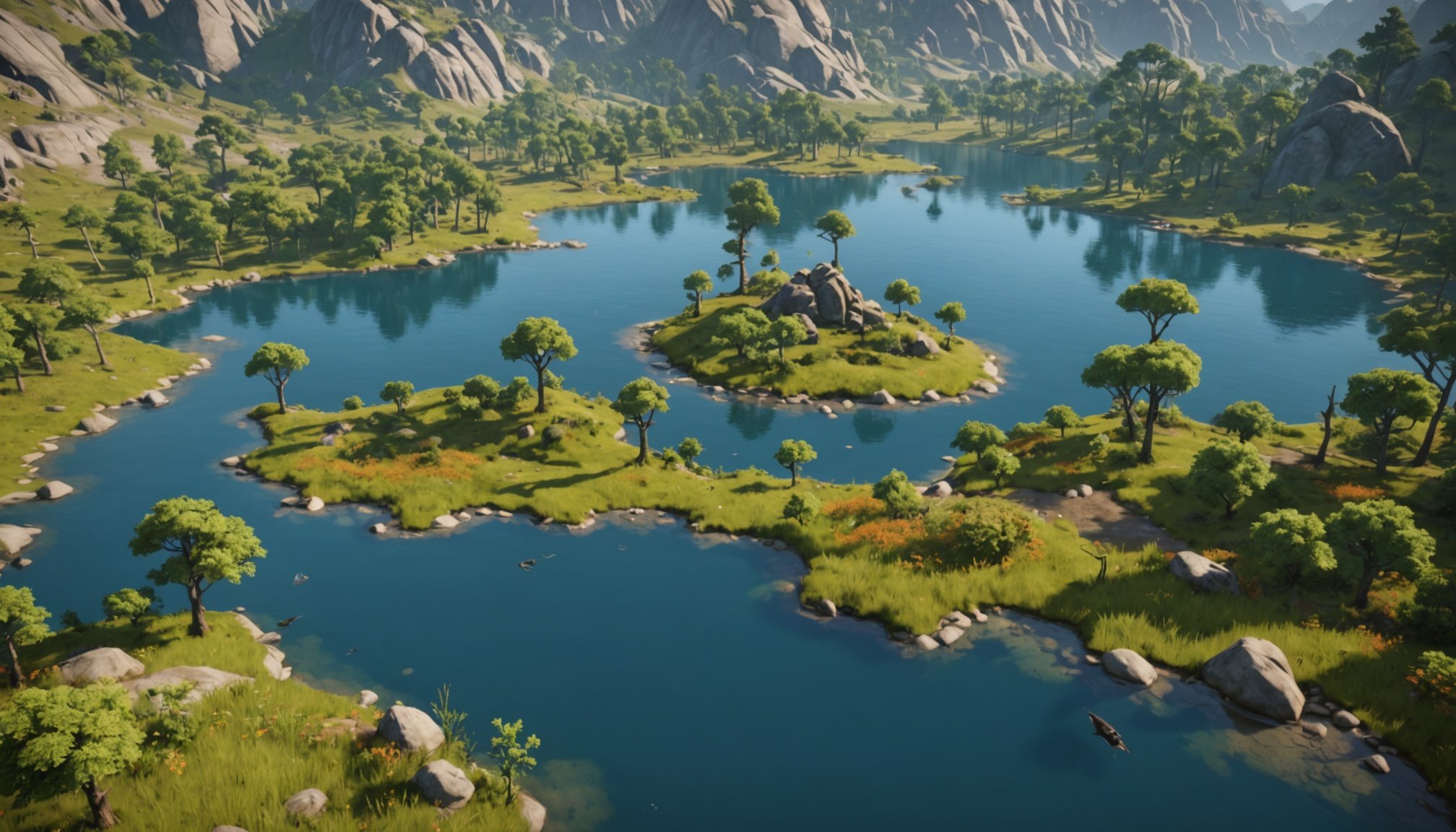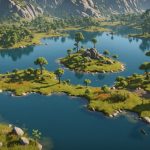Unlocking Dynamic Wildlife Worlds: Leveraging Real-Time Biome Data for Engaging Ecosystem Simulation in Games
In the ever-evolving world of gaming, the integration of real-time biome data is revolutionizing the way we experience and interact with virtual ecosystems. This article delves into the exciting realm of using real-time biome data to create immersive and engaging ecosystem simulations in games, highlighting the technologies, methodologies, and benefits involved.
The Power of Real-Time Biome Data
Real-time biome data is the backbone of modern ecosystem simulations. This data, often gathered through advanced sensors, satellites, and other monitoring technologies, provides a continuous stream of information about the health, dynamics, and interactions within various biomes.
Topic to read : Unlocking Game Economies: Leveraging Machine Learning for Optimal In-Game Financial Systems
Advanced Data Capture and Analytics
The use of advanced data capture equipment and analytics, as discussed in the “Making Nature Visible” report by KPMG, enables real-time monitoring and predictive capabilities for biodiversity[3]. This technology allows game developers to incorporate dynamic, high-resolution data into their games, making the virtual environments more realistic and responsive.
For instance, the Landler system, developed by The Landbanking Group, can monitor and generate biodiversity units from any biome around the world, providing dynamic, high-resolution data that can be integrated into game environments[2].
Also read : Unlocking Endless Cityscapes: The Role of Procedural Generation in Urban Planning Game Development
Building Realistic Ecosystem Models
To create engaging ecosystem simulations, game developers must build realistic models that reflect the complexities of real-world biomes.
Using Machine Learning and Deep Learning
Machine learning and deep learning algorithms play a crucial role in analyzing and interpreting the vast amounts of biome data. These technologies enable the creation of generative models that can simulate the behavior of ecosystems, including the interactions between different species and their environments.
For example, variational inference and deep learning can be used to model the complex relationships within ecosystems, allowing for more accurate and realistic simulations. This approach helps in predicting how ecosystems might respond to various changes, such as climate change or the introduction of invasive species[5].
Presentation and Use in Games
The presentation of biome data in games is critical for creating an immersive experience.
Dynamic Environments
Games that incorporate real-time biome data can feature dynamic environments that change based on real-world conditions. This could include seasonal changes, weather patterns, and even the impact of climate change.
- Seasonal Changes: Games can reflect the changing seasons by altering vegetation, animal behaviors, and weather patterns in real-time.
- Weather Patterns: Real-time weather data can be used to create more realistic weather conditions in the game, affecting gameplay and ecosystem dynamics.
- Climate Change: Games can simulate the long-term effects of climate change, such as rising sea levels, melting ice caps, and shifts in species habitats.
Interactive Ecosystems
Interactive ecosystems allow players to engage with the virtual environment in a more meaningful way.
- Player Impact: Players’ actions can have direct impacts on the ecosystem, such as deforestation affecting local wildlife or pollution altering water quality.
- Resource Management: Players must manage resources sustainably, balancing their needs with the health of the ecosystem.
- Educational Value: By interacting with realistic ecosystems, players can learn about biodiversity, conservation, and the importance of sustainable practices.
Collaboration and Open Source Initiatives
Collaboration between game developers, scientists, and conservationists is essential for creating accurate and engaging ecosystem simulations.
Open Source Databases
Open source databases like the Ocean Biogeographic Information System (OBIS) and the Global Invasive Species Database provide valuable resources for game developers. These databases offer comprehensive information on marine and terrestrial species, their habitats, and the impacts of invasive species[1].
Scientific Input
Scientists and conservationists can provide critical input on the accuracy and realism of the ecosystem models. For example, the Marine Species Identification Portal, developed by ETI BioInformatics, offers detailed identification keys and information on marine species that can be used to create more accurate simulations[1].
Case Study: Integrating Biome Data in a Simulation Game
Let’s consider a case study of a game that integrates real-time biome data to create a dynamic and engaging ecosystem simulation.
Game Example: “EcoWorld”
In “EcoWorld,” players manage a virtual island ecosystem, making decisions that impact the environment, wildlife, and human settlements. The game uses real-time biome data from sources like OBIS and the Global Invasive Species Database to simulate the island’s ecosystem.
- Real-Time Weather and Climate: The game incorporates real-time weather data and climate models to simulate the effects of weather patterns and long-term climate change on the island’s ecosystem.
- Player Actions and Ecosystem Response: Players’ decisions, such as deforestation or pollution, have immediate and long-term effects on the ecosystem, which are simulated using machine learning and deep learning algorithms.
- Educational Content: The game includes educational modules and real-world case studies to teach players about biodiversity, conservation, and sustainable practices.
Practical Insights and Actionable Advice
For game developers looking to integrate real-time biome data into their games, here are some practical insights and actionable advice:
Start with Reliable Data Sources
- Use open source databases and scientific resources to gather accurate and comprehensive biome data.
- Collaborate with scientists and conservationists to ensure the accuracy and realism of the ecosystem models.
Invest in Advanced Analytics
- Utilize machine learning and deep learning algorithms to analyze and interpret biome data.
- Implement variational inference and other advanced statistical methods to model complex ecosystem relationships.
Create Dynamic and Interactive Environments
- Incorporate real-time weather and climate data to create dynamic environments.
- Allow players to interact with the ecosystem in meaningful ways, such as managing resources and observing the impacts of their actions.
Focus on Educational Value
- Include educational content and real-world case studies to teach players about biodiversity and conservation.
- Use the game as a platform to raise awareness about environmental issues and promote sustainable practices.
The integration of real-time biome data into ecosystem simulation games is a game-changer for the gaming industry. By leveraging advanced data capture technologies, machine learning algorithms, and open source databases, game developers can create immersive, realistic, and engaging ecosystem simulations. These games not only provide entertainment but also serve as valuable educational tools, promoting awareness about biodiversity, conservation, and the importance of sustainable practices.
As we move forward in this exciting field, the potential for collaboration between game developers, scientists, and conservationists is vast. Together, we can unlock dynamic wildlife worlds that not only captivate players but also contribute to a better understanding and protection of our real-world ecosystems.
Table: Comparison of Key Biome Data Sources
| Database | Focus | Data Types | Accessibility |
|---|---|---|---|
| OBIS | Marine biogeographic data | Species distribution, habitat information | Open access |
| Global Invasive Species Database | Invasive species | Species biology, ecology, native and alien range | Open access |
| Marine Species Identification Portal | Marine species identification | Identification keys, species descriptions, illustrations | Open access |
| BioOne | Bioscience research journals | Full-text articles, bibliographic information | Subscription-based |
| sciBASE | Scientific bibliographic databases | Aggregated bibliographic data from multiple sources | Subscription-based |
Detailed Bullet Point List: Benefits of Integrating Real-Time Biome Data in Games
- Enhanced Realism: Real-time biome data makes the game environment more realistic and dynamic.
- Educational Value: Players learn about biodiversity, conservation, and sustainable practices through interactive experiences.
- Player Engagement: Dynamic environments and interactive ecosystems increase player engagement and immersion.
- Scientific Accuracy: Collaboration with scientists ensures the accuracy and realism of the ecosystem models.
- Public Awareness: Games can raise awareness about environmental issues and promote public health by highlighting the impacts of human actions on ecosystems.
- Decision Making: Players learn about decision-making processes in managing ecosystems, which can translate to real-world applications.
- Geographic Reach: Real-time data can be used to simulate ecosystems from around the world, offering a global perspective on biodiversity and conservation.
- Time Series Analysis: Real-time data allows for time series analysis, enabling players to observe long-term changes in the ecosystem.
- Causal Inference: Machine learning algorithms can help players understand the causal relationships between their actions and the ecosystem’s response.
- Social Media Integration: Players can share their experiences and learnings on social media, promoting a broader discussion on environmental issues.
By embracing these technologies and methodologies, we can create a new generation of simulation games that not only entertain but also educate and inspire players to care about and protect our planet’s precious ecosystems.






